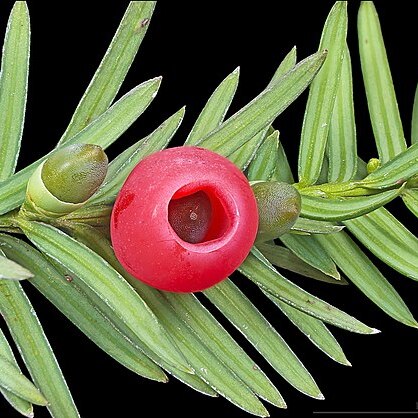Trees or shrubs evergreen, dioecious; branchlets irregularly alternate, basal part with few or several persistent or early deciduous bud scales; winter bud scales overlapping, with prominent or indistinct, longitudinal adaxial ridges. Leaves 2-ranked, spirally arranged, sessile, or shortly petiolate in Taxus cuspidata, linear, straight or falcate, decurrent, adaxial surface with raised midvein, abaxial surface with 2 pale gray, grayish blue, or pale yellow stomatal bands, resin canal absent. Reproductive structures axillary, solitary. Pollen cones pedicellate, globose, with overlapping bracts at base; microsporophylls 6-14, shield-shaped, each with 4-9 radially arranged pollen sacs. Seed-bearing structures subsessile, with several overlapping bracts, 2 or 3 distal pairs of which are decussate. Aril red or orange when ripe, succulent. Seed nutlike, ripening in 1st year, enclosed within cupular aril but with apex exposed; hilum prominent. Cotyledons 2. Germination epigeal. 2n = 24.
Trees or shrubs dioecious or monoecious. Bark reddish brown, scaly. Branches ascending to drooping; twigs irregularly alternate, green or yellow-green when young, reddish brown in age. Leaves often appearing 2-ranked, flexible; stomates abaxial, in 2 broad, pale bands; apex soft-pointed, mucronate, not sharp to touch; resin canal absent. Pollen cones globose, yellowish, with 4--16 peltate sporophylls, each bearing 2--9 sporangia. Ovule 1. Seed maturing in 1 season, brown; aril scarlet to orange-scarlet, soft, mucilaginous, thick, cup-shaped, open at apex, exposing hard seed coat; albumen uniform. x = 12.
Trees or large shrubs with scaly bark. Lvs linear, those on the spreading branches (excluding erect vegetative and juvenile shoots) arranged in 2 ranks with upper surfaces ± in 1 plane. Winter buds with imbricate scales. ♂ fls solitary in axils of the preceeding year's lvs, subglobose, each consisting of 6-10-(14), peltate or shield-shaped anthers; anthers with 4-9 pollen sacs (anther cells). ♀ fls axillary, usually solitary, rarely paired, with several imbricate scales; ovuliferous scale terminal, bearing 1 erect ovule. Seed bony, surrounded by a cup-shaped, red, fleshy aril, ripening in first year.
Fleshy covering of the seed bright orange-red at maturity, globular-cupuliform, open at the end. 10, widespread, mainly N. Temp.

